#kowloon walled city
Text
Though actually, cute thing: there are "standard" photos of the Kowloon Walled City that are always passed around, and they tend to be the most modern ones due to quality & availability reasons:

But these are from a unique period in its history, namely the end of its history - right before it was demolished. However, it wasn't the only thing to go; its removal was part of a much wider project to level and redevelop the entire area of the Kowloon City District. It just happened to be the last part to go due to its size and legal complexity. That "island of concrete in a desert" look is essentially a fiction:
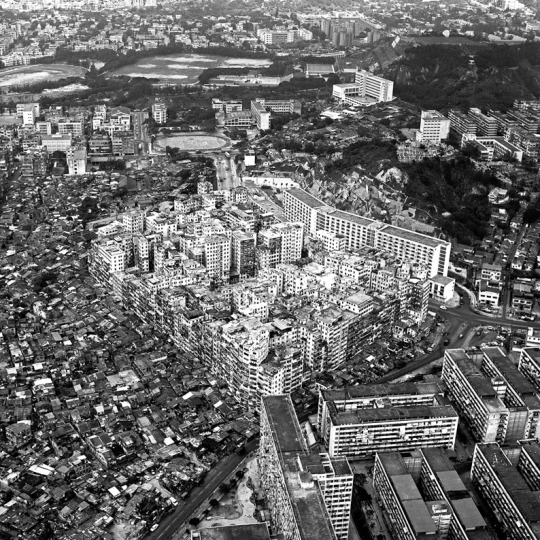
It was really the heart of a dense urban ecology of low-income development that had emerged over 30+ years in the postwar era.
And you can see how integrated it was with its surroundings, the "walls" were after all purely a legal concept:

The common photos imo are also popular because they heighten the dystopian aspects of the city, making it appear like a tumor infecting the area. Once you see it in its proper context its place as an organic part of the city is much more clear.
4K notes
·
View notes
Text
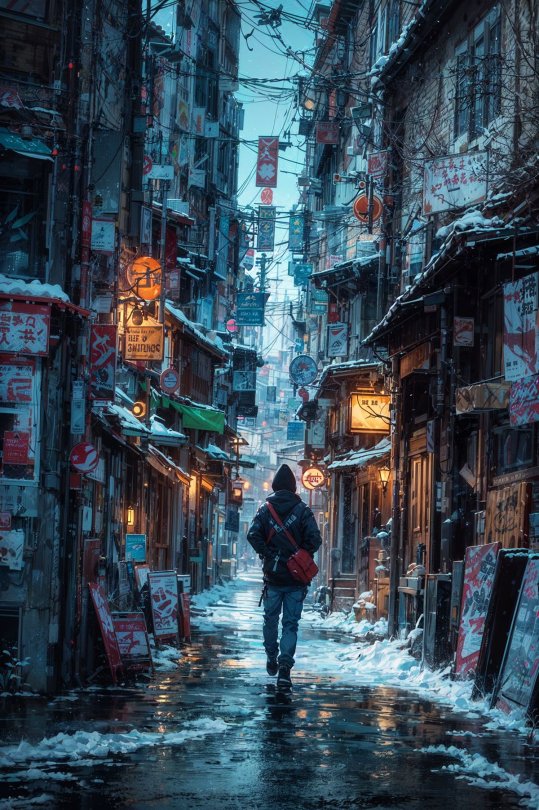


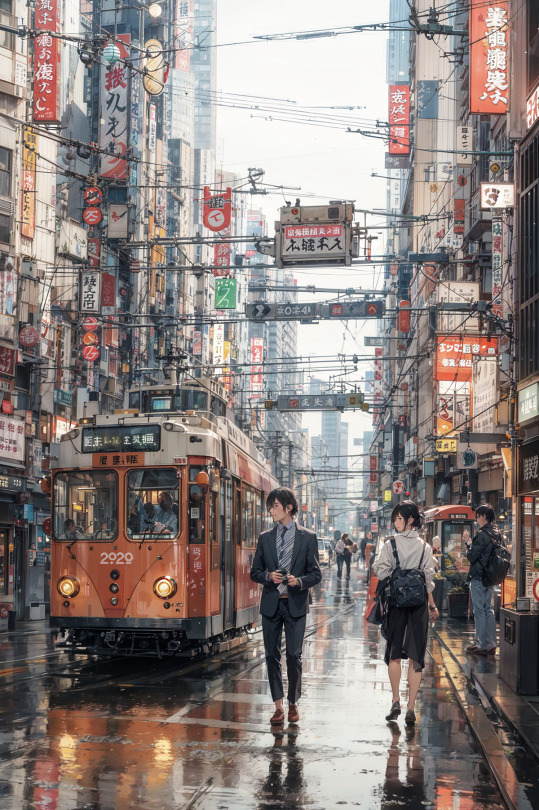
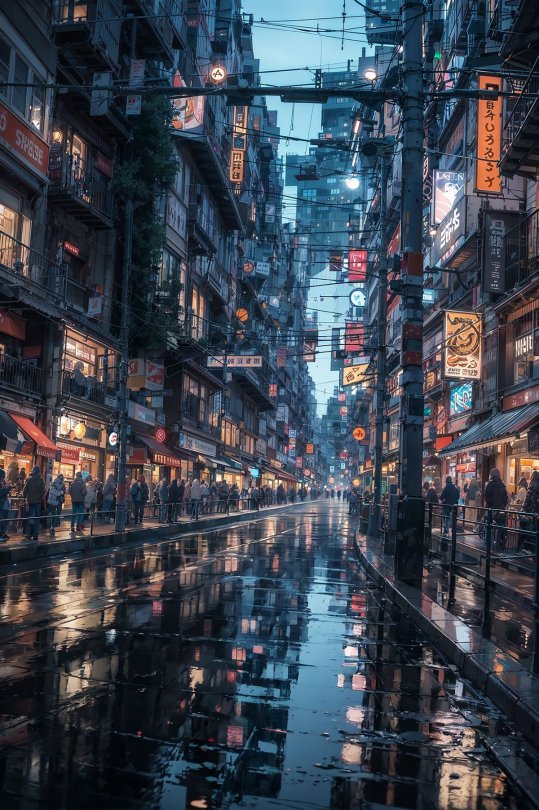

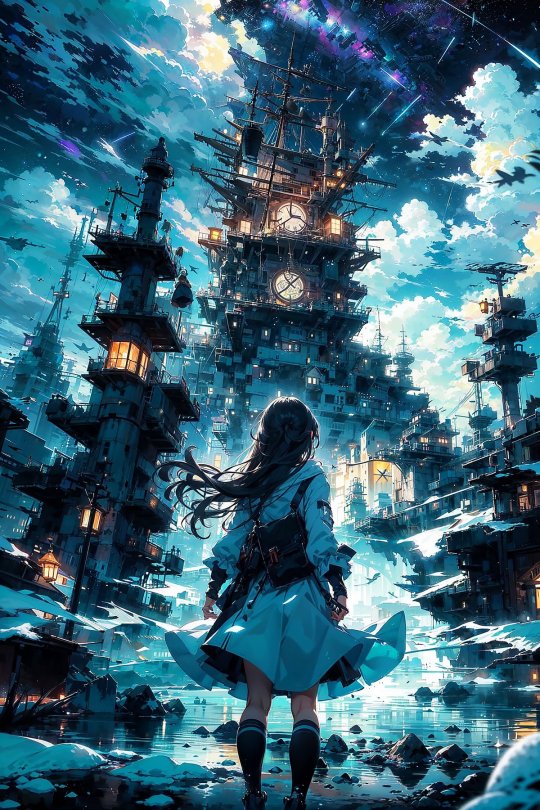



By intarku_aiart
#nestedneons#cyberpunk#cyberpunk art#cyberpunk aesthetic#cyberpunk artist#art#cyberwave#megacity#futuristic city#scifi#ai art#kowloon#urban#urban decay#kowloon walled city#ai artist#ai artwork#aiartcommunity#thisisaiart#stable diffusion
936 notes
·
View notes
Text

"Kowloon Walled City—Caged Balconies," 1990, photo by Ian Lambot.
(M+)
764 notes
·
View notes
Text


Kowloon Walled City, day and dusk. Shot by Heather Coulson and Greg Girard.
248 notes
·
View notes
Text
The weird and wonderful history of Kowloon as a digital interactive space - Part I

The Kowloon Walled City was one of the most emblematic locations in Hong Kong due to its irregular, fast-paced and largely ungoverned growth within a minute parcel of land. During the occupation of Hong Kong Island by the British in the mid 18th century, the Qing authorities surrounded the area with walls, turning it into a strategic position from where to closely inspect the foreign nation's covert activities. Almost a century later, during World War II, the area was seized by the Japanese, who tore down the walls and repurposed the stone for the construction of a nearby airport.
After the war ended, China would eventually regain possession of the city, though the disinterest of local authorities in addressing its increasing social disturbances placed it in a downward path to a state of utter degradation. By the 1970s, Kowloon had become the epicentre of Hong Kong's criminal underworld, dominated by a handful of its most vicious Triads.
Towards the last years of its existence, the ancient settlement was as a precarious heap of concrete, sheltering nearly half a million people within less than seven acres of land. Cultural and political changes in China made it increasingly difficult for this urban anomaly to remain unaddressed. In the late 1980s, an action plan was put together aiming to relocate its inhabitants and reconvert the real estate into an inner-city park. Stories about residents refusing to leave were featured prominently in newspapers all over the world, confusing many a reader as to why anyone in their right mind would choose to live in such insecure and unsanitary conditions.
Once the single most densely populated area in the world, this enclave was an architectural aberration whose disconcerting aesthetic influenced numerous works of art in different fields of creation, including a small yet consequential number of video games. This article is as a tour of those interactive experiences through which we can still partake in a small sample of what it was like to exist in this abominably transfixing space.
九龍島 (Kyu-Ryu-Tou) - Starcraft - 1986

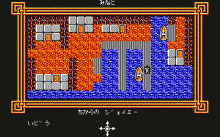
The year is 2025. An arms dealer escalates the tensions between East and West by developing a genetic weapon in a secret base at Kowloon Island. The United Nations react by sending in their best man, Jamie Starr. Unrelated to the Walled City itself, the first game to be located in the Kowloon peninsula - and indeed include the name as a part of its title - is this obscure turn-based RPG, Kyu-Ryu-Tou for the NEC PC88 and FM-77 machines.
The game is a sequel to Shangai, released the year before, featuring the same protagonist. Starcraft would also go on to produce a third instalment in 1987 named TO.KY.O. Clearly there wasn't much regard here from the developers part for geographic accuracy, as Kowloon is depicted here as being an island. While Hong Kong's southern territory is composed of an actual island, all the different areas named Kowloon are located in the mainland.
Riot City - Westone - 1991
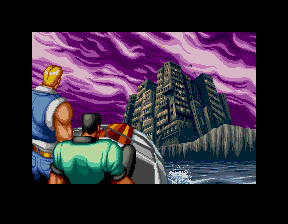

One of the most shameless specimens among a relatively long list of Final Fight clones, Riot City contains subtle references to Kowloon, though never referring to it by name. Two narcotics detectives are assigned with the mission of dismantling a cartel running a crime-ridden located in fictional Riot Island. This recurring yet geographically nonsensical notion of Kowloon as an island comes up here, yet again.
The final moment of the introduction sequence for this minor Sega arcade success shows both protagonists approaching a tight cluster of buildings whose source inspiration is quite unmistakable. Because Westone maintained ownership of most of this production's intellectual property, a later port to the PC Engine entitled Riot Zone was made possible with the help of Hudson soft.
Kowloon's Gate - Zeque - 1997
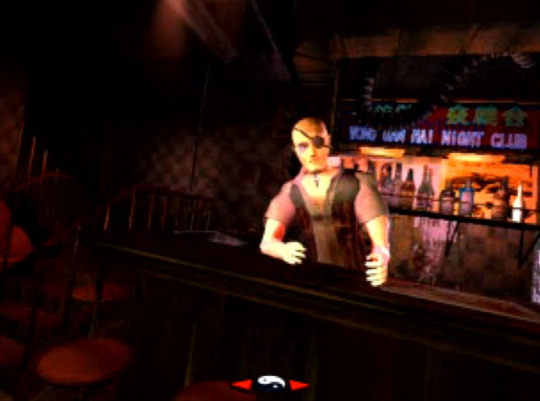
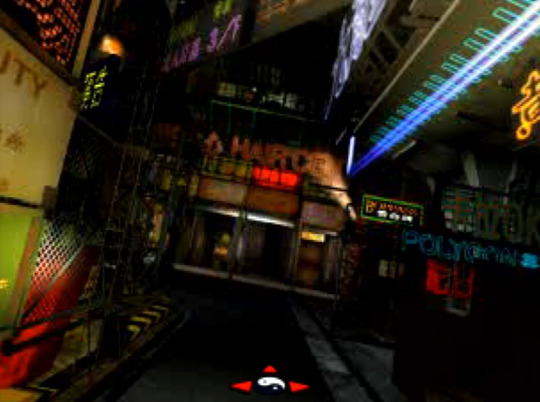
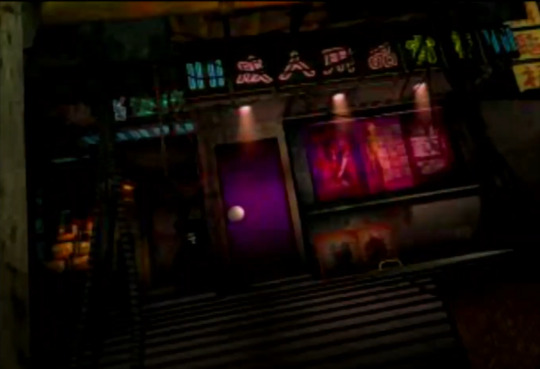
Reviving the Walled City through the lens of cybermystic surrealism, Kowloon's Gate is a dense, daunting adventure masterfully capturing the slum's dark and narrow recesses. This 1997 Japanese Playstation exclusive spans across four discs of unparalleled full motion 3D CGI spectacle, alternating with real-time 3D dungeons brimming with outlandish characters and concepts deeply inspired by Chinese history, geography and cultural traditions.
Ironically, Zeque managed to embed the theme of Feng-Shui, the ancient geomantic art seeking harmony between the individual and their surrounding space, into a story set in the world's most historically untidy district.
SaGa Frontier - Square - 1997
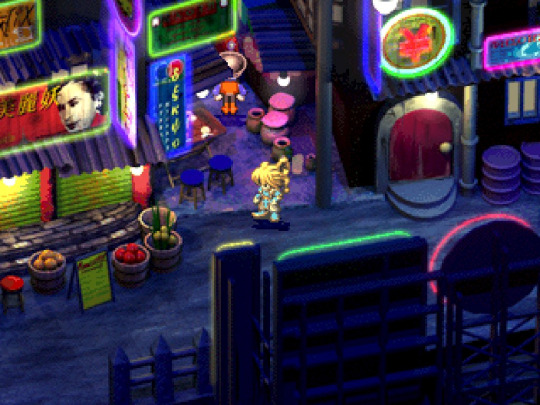
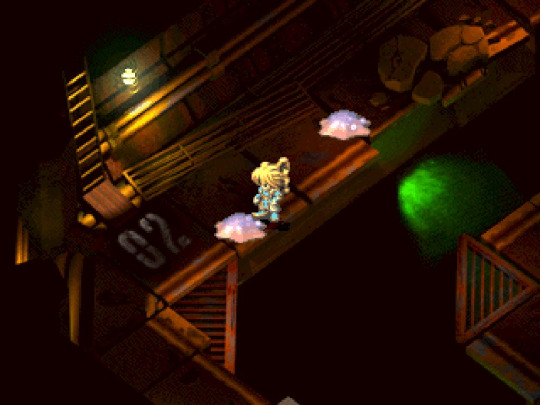
SaGa Frontier takes place in a solar system named The Regions, composed of multiple inhabited worlds for the player to explore, each with its different degree of civilizational development and culture. One of these planets goes by the suggestive name Kūron. Its pervasive neon light signs, food stalls, makeshift cabins and rooftop scaffolding instantly evoke the memory of China’s so-called city of darkness.
Shadow Hearts - Sacnoth - 2001

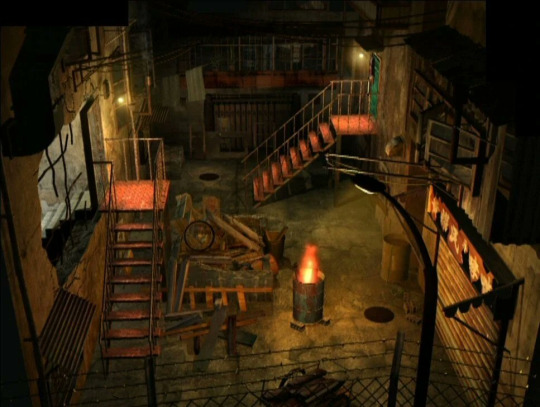
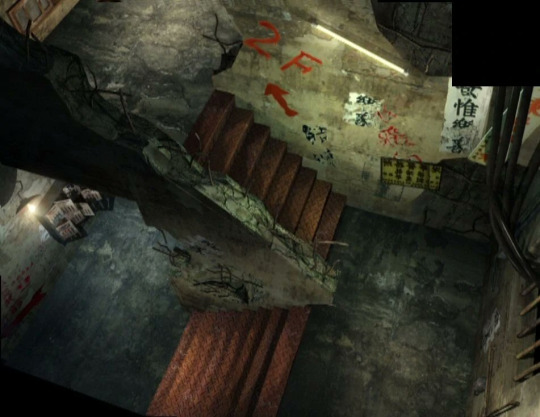
Shortly after the release of Koudelka, Sacnoth's initiated the development of Shadow Hearts, the first episode from a cult RPG trilogy exclusively designed for the Playstation 2. In good Japanese fashion, the game proposes an anachronistic yet visually suggestive depiction of Kowloon, portraying its architectural style and degree of decay as it existed in the late twentieth century, despite the fact that the game's events take place during the nineteen twenties.
Just as noteworthy is the almost complete absence of any inhabitants, which inadvertently make this portrayal of the quarter eerily reminiscent of the state in which it was found circa 1993 or 1994, as local authorities brought the long, arduous eviction project to a close.
Shenmue II - SEGA AM2 - 2001


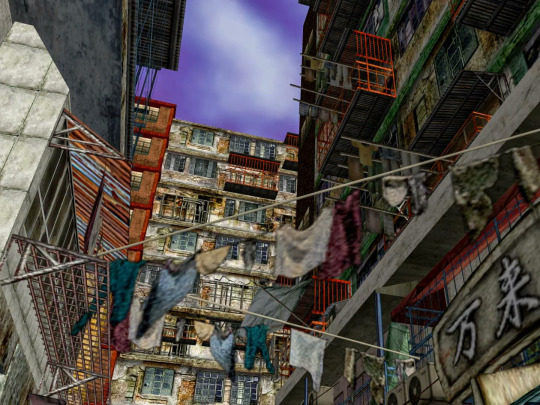
Shenmue II exhibits the most complete and period-accurate video game representation of Kowloon to date. While more recent games featuring this area may represent a number of its aspects with the aid of improved visual fidelity, none features it with such depth as this masterpiece of masterpieces. More than mere background decoration, Kowloon exists in the Shenmue series as a crucial, climacteric element of its modern epic narrative.
It is a well known fact that Yu Suzuki and his team conducted extensive research of the region so as to achieve a result that impresses even to this day. It must be noted, however, that they have similarly taken a fair share of creative liberty when converting the area to best align with the themes they wished to explore. Further reading is required for a more complete context in this regard, namely how this area ties with an early Dreamcast tech demo design which fans lovingly named Tower of Babel.
Ostensively, technical limitations did curtail the degree of precision in which the surrounding area could be replicated. The aerial view from the cutscene in which Ryo Hazuki arrives on location places Kowloon at an imaginary degree of elevation over surrounding vegetation. In the year of 1987, during which the game is set, the actual enclave stood perfectly levelled with a myriad of other modern buildings, undoubtedly more than could be reproduced under the circumstances.
These trifling considerations aside, Shenmue II entirely succeeds in capturing the vibrant life and mesmerizing beauty of the destitute and decayed urban agglomeration, in a way that it was deemed entirely impossible at the time of its release.
For reasons entirely related to per post content limitations imposed by Tumblr, this article will be continued in PART II.
#china#hong kong#kowloon#kowloon walled city#videogames#Kyu-Ryu-Tou#riot city#saga frontier#kowloon's gate#shenmue ii
369 notes
·
View notes
Text
Kowloon Walled City, photographs by Greg Girard




709 notes
·
View notes
Text

Infographic flyer of Kowloon Walled City 1898 - 1993 and now.
36 notes
·
View notes
Text
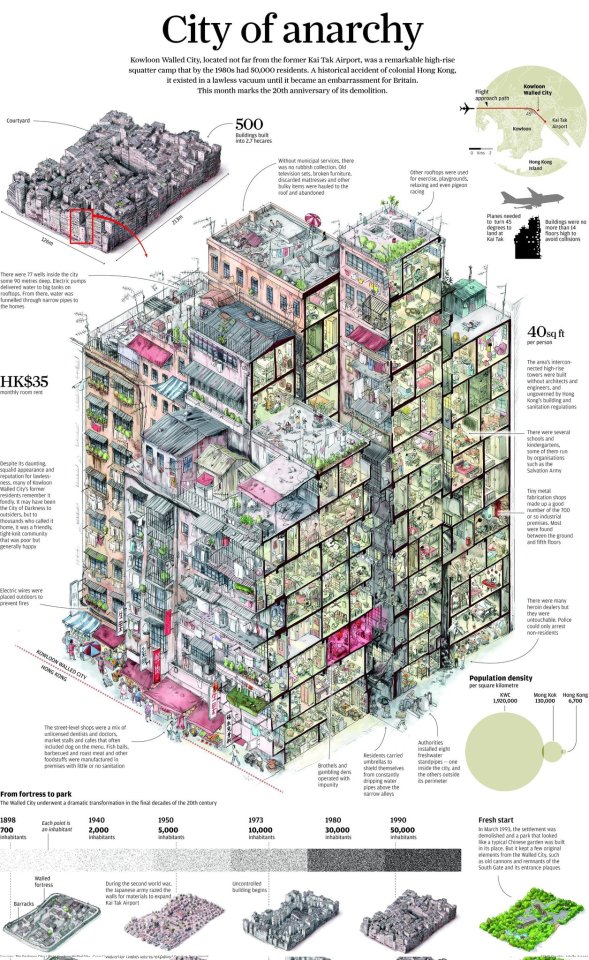


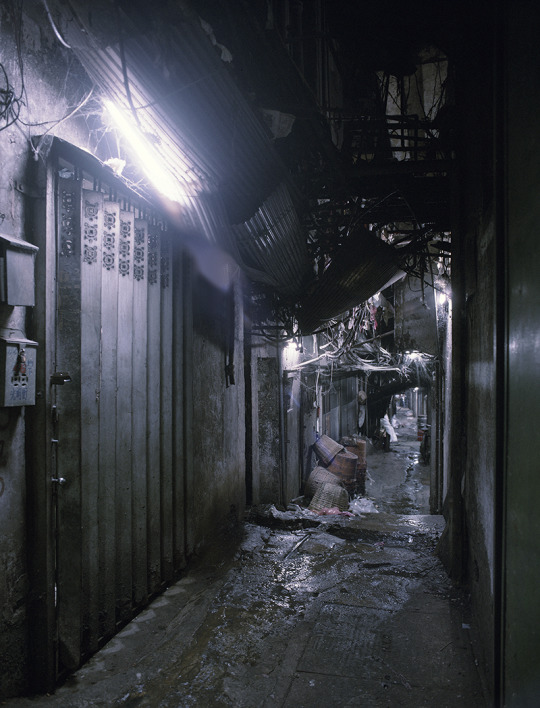
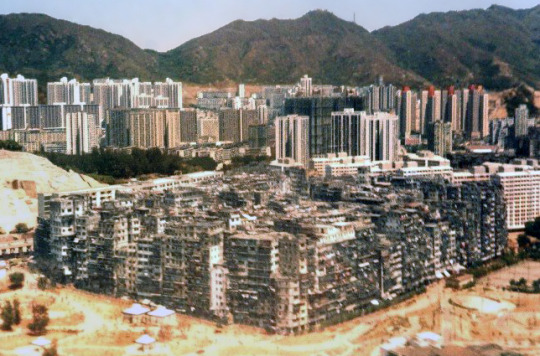


Various images inside and outside of Kowloon Walled City (demolished in 1993-1994), and replaced with a park because we can't have anything nice or not controlled by the state.
#kowloon#kowloon walled city#urban landscape#look how they massacred my boy#or however the city thought of itself
74 notes
·
View notes
Text
Visiting the Dragon's Nest District
Most cities and towns in No Man's Land have been similar in appearance, with a ship or a portion of a ship watching over its people. However, in Ryutsu, where many things happen, the ship is not the only structure that dominates the landscape.
I wanted to do a dive into the city, what inspired it (and speculate on some of the visuals) and what we can potentially understand about No Man's Land.
Some spoilers for Vol. 4 and 5. Also, this is long.
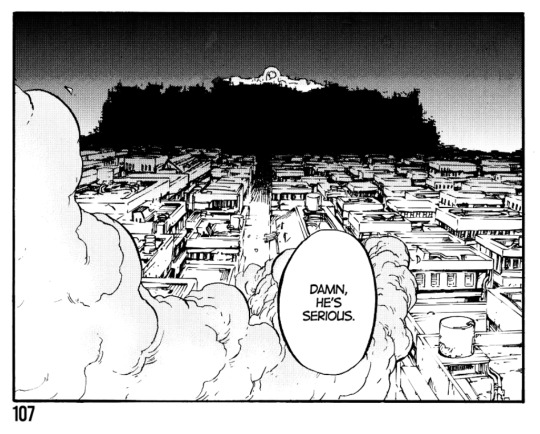
Even without the baos and wonton-fonts on signage, Ryutsu visually does not match with other cities in No Man's Land. It’s not just the citadel which can be seen from afar, but it’s also the crammed housing and confusing architecture. The tone of Vol. 4 shifts and leans towards neo-noir. As this arc's villains move into the city, Hoppered says: "This place is truly the bottom of the dark. [...] We'll walk into a place where the light does not enter." These lines may not be literal but it certainly brings ideas of seedy places. They move through pitch black and eventually…
The big showdown happens at the city's main feature: the Dragon’s Nest District - an area that brings up memories of the old Kowloon Walled City in Hong Kong. No Man's Land is a sparsely populated planet, yet for whatever reason, people have sardined themselves into this city and into this district.
Kowloon Walled City had been called ‘City of Darkness’ and it was possible to move through the city without ever seeing daylight. It carries a bit of romantised nostalgia because of its weird part in Hong Kong colonial history, its uncontrolled and chaotic construction, and its lawlessness (though apparently the ungoverned city was tight-knit and communal). The city became a source of inspiration for a lot of media, but not many films were shot in the city itself. Those that I had seen tended to use the city as a 'cool film location' so apart from the examples below, there aren't many I know to recommend (happy to take suggestions for films I may have missed).
youtube
Clip from Bloodsport (Arnold, 1988)
"No joke, man. It's a random piece of No Man's Land in the middle of a tourist paradise. It goes way back to the old lease agreement between Great Britain and China. Once you step out of the sunlight into the narrow corridors, it's time to protect your nuts, guys."
youtube
Clip from Crime Story (Wong, 1993). This is the climax of the film, which featured actual explosions from Kowloon's demolition, according to its wiki page.
Off the top of my head, good fiction film substitutes (unrelated and unlike Trigun/Trimax) which more illustrate what life might have been like in these places, may be films like Wong Kar Wai's Fallen Angels (1995) and Chungking Express (1994) - though these films take place at the Chungking Mansions, Kowloon Walled City's more modern cousin. I thought of Wong's films because he treated the mansions as a character more than as a location. His films showed examples of immense density, globalisation, and a bit of that noir crime stuff within small and unusually intimate spaces. They also reflected Hong Kong's complicated anxiety as the city was approaching its handover from British to Chinese rule.
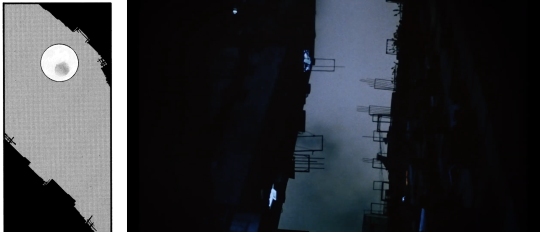
Panel from Vol. 4 Ch. 7; Screencap from Chungking Express (Wong, 1994).
To talk more about Hong Kong cinema itself would be much longer than a tumblr post but if Nightow is connected with Rodriguez's films via Desperado (1995), Rodriguez and his collaborative friend Tarantino are connected with Hong Kong films from those like John Woo and Ringo Lam. One example: Mexican standoffs are tropes used in various films, but we see them frequently enough in Tarantino's films and in Hong Kong action cinema that it becomes noteworthy.

Panel from Vol. 5 Ch. 3

Panel from Vol. 5 Ch. 5
Kowloon Walled City which was demolished in 1993, was visually ‘resurrected’ as Ryutsu's Dragon's Nest. Kowloon Walled City was not a city that just looked interesting. It was an agreement between China and Great Britain that was then kind of weirdly botched, thus leaving it pretty much ungoverned. Trimax Vol. 4 was released in 2000, three years after Hong Kong's handover from Britain to China. We don’t get Ryutsu’s history and with the multiple panels of silhouetted buildings against the night sky and hanging laundry in balconies, Ryutsu’s citadel falls into the 'cool manga location' category. Also, I should be clear: these chapters in Trimax are not an analysis or an allegory of Hong Kong's colonial history.
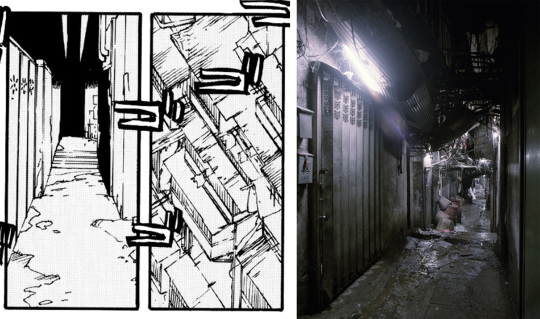
Panel from Vol. 4 Ch. 4; Photo of Kowloon Walled City's alleyway from wiki article.
At the same time, many eyes, including those outside of Great Britain and China, were on the news when the handover occurred. The point is not if Nightow was considering that historic moment or if he happened to be watching Hong Kong films when he was working on these chapters. Instead, I wonder if readers, when they picked up these volumes from the bookshelves, had thought about Hong Kong, Hong Kong’s movies, and Hong Kong’s past and uncertain future, as they were skimming through the pages. But you know… this is 2023 me thinking about 23 years ago. All of this is daydreaming.
I bring up Hong Kong's history and cinema because I wanted to see what I can envision and interpret about Ryutsu and thus about No Man's Land. If Hong Kong via cinema brings imaginations of transnationalism then Ryutsu via Vol. 4 and 5 could do the same for No Man's Land.
There is no literal ocean to divide cities and there are no named countries. There is a broad ‘Federal Government’, so I assume that means the government concerns itself with all settlements in the entire planet. If Ryutsu itself is No Man’s Land’s ‘Hong Kong’ (which opens another discussion of the use and/or misuse of Hong Kong in media - some other time), then despite No Man’s Land being an incredible dystopia, the elimination of borders is, very plainly, very interesting. I am leaning to this being a good thing, considering that one major problem in No Man’s Land tends to be ‘Humans vs. X’ (plants, worms, the planet’s environment etc.). Also, No Man’s Land is already very sparse. No spoilers for later volumes but I am curious about the planet’s future if the population demographic changes.
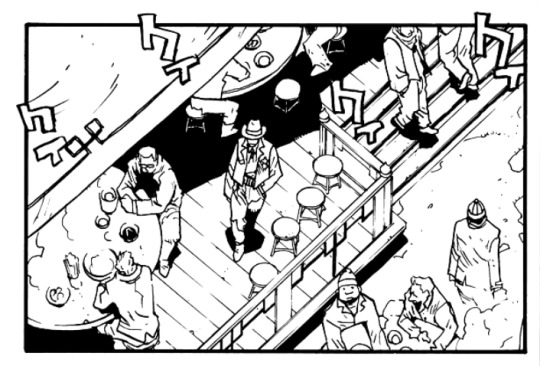
Panel from Vol. 4 Ch. 4. Western and Eastern hats in the same panel.
There are also thoughts about its class struggles. Vash says in Vol. 4 Ch. 4: "There are too many people here. I don't like it. The lower and upper class all cramped together." ... which really made me think about the conditions the upper class were living in. Kowloon Walled City was known to be unhygienic, dark and cramped and the wealthy did not live there, so how rough was it to live in Ryutsu when a rich person might still need to live in the citadel? I didn't interpret Vash's statement to mean 'citadel plus those outside of it' when the high stakes in these volumes were because of the high density and maze-like streets.

Panels from Vol. 4 Ch. 6; Ch. 7; Ch. 7.
The above panels remind me of establishing shots in gritty crime thrillers than the sci-fi western I had been reading up to this point.
Featured is the Juukei Building - a building that looks pulled from the 20th century. It is tall, drawn sometimes in narrow panels to emphasize its height and to show how small the characters are in the claustrophobic space as they navigate towards it. As characters move through the structure once inside, it becomes more difficult to tell where in the building they are or if they are somewhere adjacent. Combining historical and futuristic designs in Trigun/Trimax isn't new, but it's not often you see 20th century structures. Maybe wealthier residents lived in buildings like this, though the interiors of Juukei look like abandoned offices.

Panel from Vol. 5 Ch. 3.
Or maybe this was meant to be a mixed-use building? But it seems the entire building is abandoned anyway.... So I'm not sure where the upper class is supposed to live or how I should imagine the upper class to be.
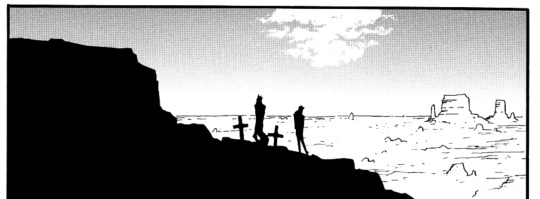
Panel from Vol 5. Ch 6.
... After the end of the battle, once morning comes, we no longer see the citadel. The landscapes return to those reminiscent of American Southwestern deserts. Like we dipped into darkness then we returned to the light.
Anyone who knows about Kowloon Walled City would instantly recognise it in Trimax. The imitative Ryutsu Citadel could be read as a cool manga location where a massive shootout plus some serious revelations occur, but I personally am always interested in what else a location can do. It matters if you set a film in New York City versus a nameless location and how you visually convey that city because it can tell us about its people and helps us understand its characters. So to me, I thought it would be fun to look at certain locations in Trimax (with all of Nightow's free-form inconsistencies and confusions) and imagine or interpret what they can tell us about No Man's Land and by extension, the people in No Man's Land.
Other fun facts include:
"[...] Japan, in particular, developed a keen interest towards Kowloon. Its demolition in 1993 was broadcast on national television."
#trigun maximum#trimax vol 4#trimax vol 5#trigunbookclub#kowloon walled city#hong kong#idle thoughts#this got out of control#also tumblr is a terrible platform for long-form rambling#absolute nightmare
72 notes
·
View notes
Text

Strays level design was heavily inspired by the Kowloon Walled City in China.
23 notes
·
View notes
Photo
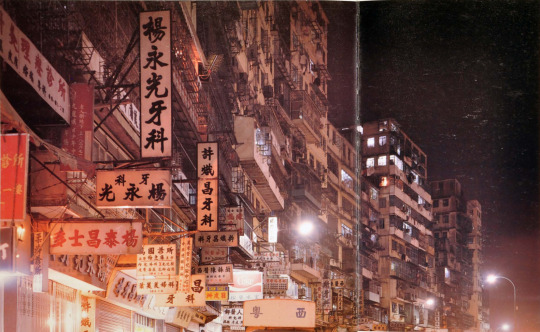
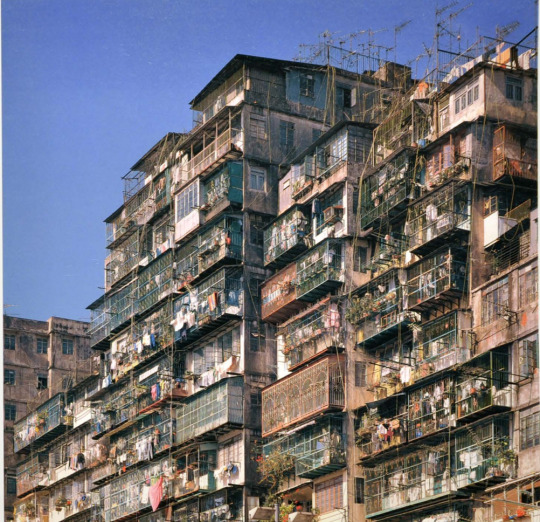
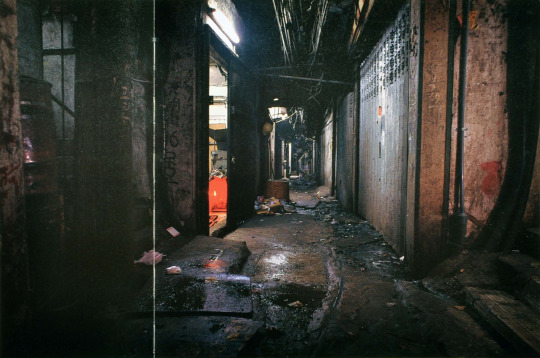

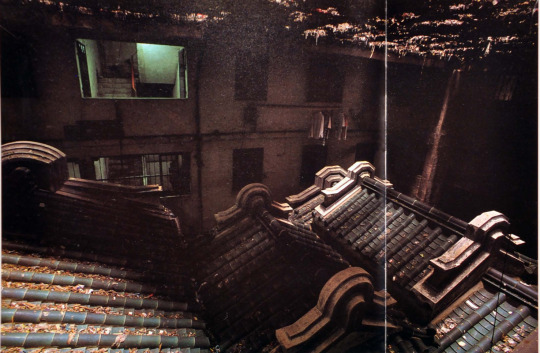


City of Darkness - Greg Girard & Ian Lambot
Home to 40,000 people at its height, Kowloon Walled City was by far the most densely populated place on earth. On a site measuring roughly 200 by 100 metres were squeezed some 350 buildings, rising 14 storeys or more and so tightly packed there was rarely space between them. Every available nook and cranny was inhabited, while the connecting alleys, stairways and corridors were reduced to an absolute minimum.
271 notes
·
View notes
Video
youtube
this is supposed to be my art-exclusive blog, BUT looked up this video to link to a friend and wound up watching half of it again because it’s so fascinating, and felt like I needed to share it. It’s a documentary about Kowloon Walled City produced by Austrian journalist and writer Hugo Portisch, filmed in the city itself in the summer of 1987 and released in 1989, four years before demolition of the city began. Today, the 6.4 acre area that once held a 14-story labyrinth of approximately 50,000 people is a public park.
the documentary is in German, with subtitles in English added by the uploader. The filmmakers’ perspective is frank in laying out the harshness of life in the city, and aims to be honest-- although the only direct interview is with a British missionary, the only white person in the whole film, and the narration makes blanket statements about broken families and an “every man for himself” attitude that contradict former residents’ own descriptions of an intensely close-knit community and households where several generations lived together, despite the tiny size of the city’s apartments. Despite these criticisms I’d make, the tone of the documentary is clearly sympathetic towards its subjects from beginning to end, and it’s a fascinating and emotional glimpse into a vanished world.
if you’ve heard about Kowloon Walled City and want to learn more, watch this thing! If you’re like me and you’ve been lowkey obsessed for years, also watch this thing! If you didn’t know about the city at all before now, you’re welcome, and watch this thing!
the uploader’s video description, which I’ve pasted below, contains additional information about the making of the documentary that adds more depth and context:
Credits go to cameraman Hamdani Milas. Christina Wesemann for creation and direction of the film and also to Hugo Portisch for production.
Milas was one of the people that helped filmed this 1989 documentary about the city. I spoke with him recently and he said that he is interested in a follow up video of some sort so we may expect something new on the way.
He mentioned how it was an incredibly tough shoot. They were a five person crew; himself as cinematographer, a camera assistant, focus-puller, sound recordist, a researcher, production assistant and the director, and a very nice Austrian lady who was most willing to collaborate and listen to crew suggestions.
They shot for 6 days continuously, 10-12 hours a day, at the height of the summer of 1987. He mentioned how it smelled very bad inside from the open drainage, the heat was stifling at plus 32ºC with little to no air circulation, also not knowing whether it was sewage or clean water dripping on their heads occasionally, they regularly had to wipe the camera and lens dry.
The claustrophobia- you could hardly turn around in some places with a 7kg Betacam SP camcorder on your shoulder. They had a tripod with them but hardly used it inside because there was nowhere to position it without blocking the narrow passageways.
They also frequently got lost and had to ask the locals for directions. Lunch was much-anticipated each day when they could take a break outside in the fresh air. After a day’s shoot they were absolutely dripping with sweat and the first thing they’d do after getting home was to put all their clothes straight in the wash and have a long shower. Working in those conditions was an immense challenge technically and physically but, as is often the case, none of that shows in the resulting footage.
Here we have a very interesting first hand account of what Hamdani Milas experienced in the walled city itself when he was filming this video. So by what he’s told me we can understand just how much of an incredible risk it was to film inside this city, even though it was near to when the city was demolished and the place was seen as safer it was still a high risk no go area.
I took it upon myself to re-sub the video as best as possible, the 4 part version is hard-subbed on a version of this film with very poor quality, the subs are also worded incorrectly in some places. So all I've done is re-subbed the whole thing and put it onto a better quality video clip.
Note: about the section of this video where Jackie Pullinger is speaking, I’m sure anyone can see the subtitles are a transcript of Jackie Pullingers actual words in English and not the narrators. I’ve noticed a comment mentioning how the subs are way off in that part. While subbing this video I realised the narrator wasn’t giving an exact translation so took it upon myself to decipher what she was actually saying over his voice. Sorry I just couldn’t help it but it was out of boredom 😉
365 notes
·
View notes
Text
By caboltx
Music on
#nestedneons#cyberpunk#cyberpunk art#cyberpunk aesthetic#cyberpunk artist#art#cyberwave#megacity#futuristic city#scifi#hologram#holocore#neon art#neoncore#neon aesthetic#neon world#kowloon#kowloon walled city#slum#future city#neon city#cyberpunk neon city#vending machine#nostalgia#nostalgiacore#nostalgeek
292 notes
·
View notes
Video
youtube
of course i've read about Fabled Kowloon. through william gibson's cyberpunk i heard about and eventually found Girard and Lambot's book City of Darkness, the seminal visual reference. seen a few urbanism videos on kowloon, but TIL there was a manga and a videogame with direct namedrops: Kowloon Generic Romance and Kowloon's Gate
20 notes
·
View notes
Text
Beyond What the Lights Could Offer - Chapter 1
Soukoku Kowloon Walled City 1980s Filmmakers AU. Prepare thyself for agonisingly slow updates, a lot of references towards Hong Kong and me screaming into the void.
original fic link on AO3 (by yours truly): Beyond What the Lights Could Offer by Lemon(ivlenyxx)
May 14th 2023, 29 years, 10 months since the release of Stray Dogs.
“Nakahara-san, Dazai-dan, nearly 30 years have passed since the release of the hit movie ‘Stray Dogs’,” the interviewer says with a smile. “It has grossed over 800 million USD at the box office and many consider it a classic. Many fans have wondered ‘Just what is the story behind the film?’. Now that’s a question that’s been asked for nearly thirty years now, so we beg of you,” she claps her hands together to form a prayer gesture and bows her head. “What exactly is the story behind Stray Dogs?”
The pair sitting opposite her both chuckle, amused.
“Alright, alright. Since it’s nearly the 30th anniversary, we’ll tell you.” the man in the fedora answers.
Nakahara Chuuya, age 52, executive producer of “Stray Dogs”, sits up straighter as he ponders the question, combing through his faded copper hair with his hand; his partner, Dazai Osamu, age 51, director of “Stray Dogs”, smirks slightly, wrinkles spreading across his face. “Come on, Chibi, can’t keep our fans waiting,” he nods towards the interviewer and the TV crew across from them. “Unless the Great Nakahara Chuuya is getting slow in his old age.” he teases, leaning over Chuuya’s neck.
Nakahara noticeably bristles under his partner’s breath, that discomfort quickly morphs into annoyance and reaches its stunning conclusion as Chuuya grabs Dazai’s collar. “I swear to God, you shitty mackerel-” he snaps as the other man whines and wallows dramatically under his grip. “We’re the same age! I can’t take a moment to think?!-”
“No! Oh no! Chuuya is attacking me!” Dazai exclaims and yaps, notes of fake panic and amusement dripping from his voice. (The interviewer sits awkwardly in silence while the rest of the crew whisper amongst themselves) “My God, this is marital violence!” He throws up his arms (making sure to flash a gold wedding band at the camera) and easily overpowers his dear Chibi, shoving him onto the far end of the couch before redirecting his attention to the interviewer, the poor unfortunate soul bearing witness to Nakahara making grabby hands at Dazai while the latter holds him off with a hand in his face. “It goes a little something like this…”
April 29th 1986, 8 years before the release of Stray Dogs.
Chuuya’s not exactly sure how he ended up here, but okay.
The red light floods the crowded, 40 square foot room, Chuuya’s eyes hurt from the strobing lights;Chuuya’s ears are bleeding from the music blasting through the crackling radio.
Oh second thought, not okay. Chuuya wants to leave.
He puts down the half finished glass of cheap whiskey before manoeuvring his way through mountains and seas of people dancing to the beat of something that just came on. (something American, he doesn’t want to know) The red lights continue to pull assassination attempts on his eyes, which is only made worse by the pixelated screens displaying images of half naked men and women “available” in this cursed brothel-nightclub hybrid. The two dozen people making out in every direction doesn’t help either.
If there was such a thing as unsee juice in this world, Chuuya would like 10 litres of it, please.
Finally, Chuuya makes it out of the brothel-nightclub, (thankfully in one piece) he looks back at the bouncer, who doesn’t even spare him a glance. Hell, he didn’t even ask him for any form of ID, despite him obviously being underaged. His short stature speaks for itself.
Guess that’s Kowloon Walled City for ya.
Chuuya makes his way through the interconnected hallways, counting and reading the posters plastered all over the place. 1, 2, 3, 4… 28. He thinks half of them are advertising stuff for the Port Mafia Gang. Interesting. He’d heard of them, of course. The most powerful underground organisation of the Walled City, operating in the dark (well, as dark as the City of Darkness could get) or even beyond. He’d heard rumours of them stretching all the way to Lantau Island and the Shatin District. Hell, even Cheung Chau’s underworld carries traces of their interference!
Not that he’s ever personally been down there, of course. The underworld, he means.
Chuuya kicks at his feet as he makes his way up to the rooftop of the building, the gate creaks agreeably every time he pushes it and it returns to its original position with a pleasant clang! He squeezes his way through the drying sheets, careful not to bump into them in his dirty clothes, and legs it across a huge pile of scrap. At last, he reaches the edge of the rooftop and leans on the railing, taking in the sight of the City in the middle of the night. There are still a few lights on at this hour, not counting the establishments of the night, aka the opium traders, nightclubs, gambling dens, makeshift casinos etc etc. He spies one on the far left, the light of the balcony flickers in a way that reminds him of moths flapping their wings, and under the light is a boy his age with black hair and a bandage over his right eye, teetering back and forth on his feet, fingers gripping tight on the handrail. His eyes are downturned, expression blank.
What a weirdo. Chuuya thinks. He turns away to light a cigarette and takes a long drag. The next time he looks, the light is off, the boy is gone.
He can’t help but feel disappointed, somehow.
Chuuya shrugs off the feeling and takes another drag of the cigarette, looking straight ahead, beyond the Walled City, at the Kai Tak Airport. Planes take off and land dangerously close to the buildings nearby, another few soar mere metres above Chuuya’s head, their loud, rumbling engines sing a comforting tune to accompany the city’s orchestra of dripping air-cons and creaky pipes down below.
It’s as beautiful as ever.
One of these days, I’m getting outta here. He vows, before putting out the cigarette and flicking it off the roof.
He doesn’t know how many hours have passed, only that this is the perfect way to celebrate his fifteenth birthday.
Chuuya continues to admire the view of the Kowloon Bay, occasionally glancing over to Victoria Harbour for a glimpse of its colourful and lively skyline. The best part about this corner of Kowloon Walled City? It contains the tallest building. One can pretty much see everything within a 20 km radius, and if one’s lucky, the clouds’ll part for the stars, and even the shortest, most 150-centimetre-ed of people could enjoy their glory.
He reaches for the radio beside him, switching between channels until he finds one that plays something that suits his favour.
It ends up being an English channel, playing something from a new writer from America.
“Now playing: The Tell-Tale Heart, by Edgar Allan Poe,” the presenter states calmly, before a low and unsettling voice takes its place, narrating the tale of an insane man who murdered his elderly housemate.
Chuuya listens absent-mindedly as he lights another cigarette and continues to watch over the Walled City, his position giving him a handy bird’s-eye view over everything else. More lights have switched on, the opium dens are starting to close, the bars and brothels are chasing people out like a restaurant owner at animals like you see in movies or it’s 20-something A.D. and they have leprosy. Must be nearly morning.
Oh shit it’s nearly morning.
His eyes widen as he catches the faint blue ring of the sun rising over the horizon and slowly but surely evolve into a blinding orange light that pours over the Sai Kung District to the east, then to the Uni of Sci and Tech, to Tseung Kwan O- Chuuya throws his cigarette over the railing for the second time before shutting off the radio and making a mad dash for the gate, legging it over the scrap, nimbly contorting his body to avoid touching the sheets, before finally bolting down the stairs and out of the building. He passes the town square - a relic from the Walled City’s past as a Song Dynasty military outpost - and nearly slams straight into a bunch of bakbaks and popos doing taichi. A couple of them yell at him for his insolence. He zips his way through alleyways full of drunkards and shakes off a madman trying to gut him with a knife, (it’s the Walled City, he’s seen worse) he looks up for a split second and stops in his tracks.
He can see the sky from here.
The small slit of bright, warm blue peeks out amongst the mess of pipes and haphazardly built roofs, the clouds dance across it in pinks, soft oranges and light yellows. Chuuya stares up at that beautiful sight through the gap, the City has never been this generous before, the most daylight he ever got to see was approximately none, except for when he headed out of the Walled City every few months to run for supplies that the Triads couldn’t access.
Chuuya looks around for a landmark that he can bookmark into his memory, and spots another one of the Port Mafia Gang’s posters on the wall to his left.
He sighs. That oughta do. And so the poster enters his mind.
He allows himself several more minutes of staring at the sky before booking it back home, he just hopes that Shirase and Yuan won’t be too pissed.
Unbeknownst to him, a boy with jet black hair and bandages all over has been looking at him through a window for a while now.
#bungou stray dogs#bungou stray dogs fanfiction#fanfiction#bsd dazai#bsd chuuya#kowloon walled city#1980s#filmmakers au#soukoku#dazai x chuuya#how do i tag this#slow burn#horrifically slow updates#original on ao3
7 notes
·
View notes
Text
The weird and wonderful history of Kowloon as a digital interactive space - Part II
This article is the continuation of a previous post.
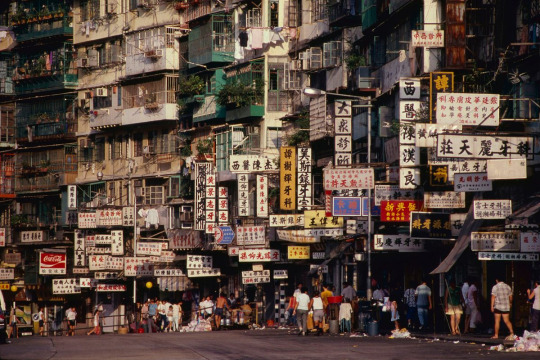
Any comprehensive history of 20th century Hong Kong is not complete without a chapter entirely dedicated to the architectural and urban planning puzzle that was Kowloon Walled City. Quite unlike any other slum in Asia or elsewhere in the world, the extreme conditions under which its inhabitants lived captured the attention of various international journalists and photographers whose reports of this accidental labyrinth, in turn, inspired some of the most remarkable artistic explorations of our time. In this regard, video games did not remain impervious to the powerfully stimulative imagery, as much a reference today as it was when its hardened concrete walls still stood tall.
Kowloon's Gate Suzaku VR - Jetman - 2017
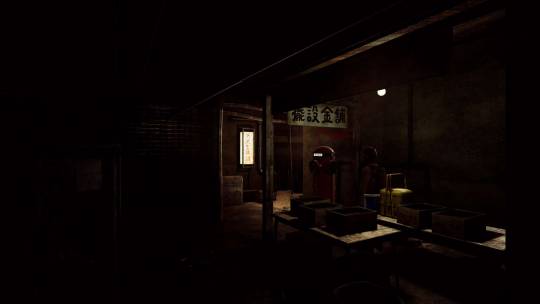
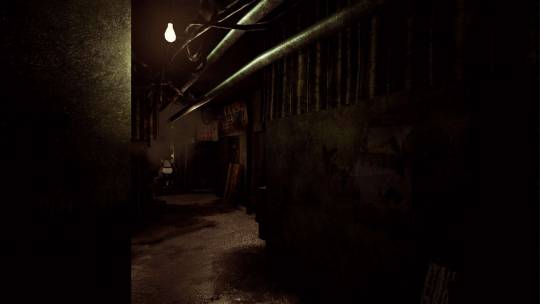
Kowloon's Gate made a most unexpected comeback twenty years after the original episode via the crowdfunded VR project Suzaku developed by Jetman, a studio founded by and composed almost exclusively of ex-SME/Zeque staff. While it is not the remaster many had hoped for, essentially consisting of a walking simulation through some redesigned locations from the original, it does a commendable job in faithfully replicating its instantly recognizable, light-starved alleyways in competent high-definition. It is also the only VR-compatible entry from this list, granting it a degree of uniqueness over its counterparts.
Stranglehold - Midway/Tiger Hill Productions - 2007
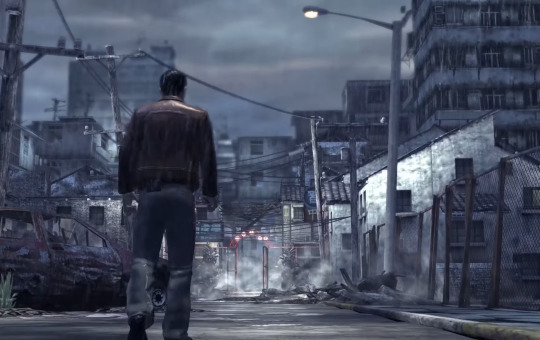
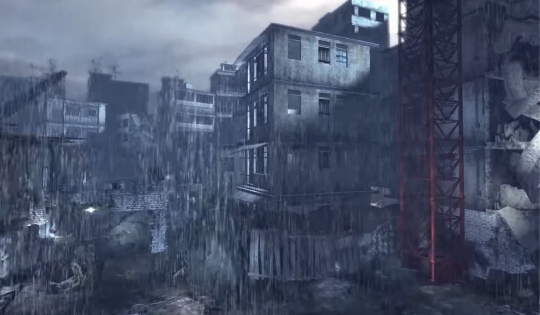
Stranglehold is the result of a collaboration with Hong Kong movie director John Woo, developed as a direct sequel to his heroic bloodshed classic Hard Boiled, featuring Chow Yun-fat in the role of detective 'Tequilla' Yuen in his unending confrontations with organized crime. One of the game's most unforgettable levels, Slums of Kowloon, takes place during a particularly rainy day, seemingly in those last days when the zone had been emptied of residents and demolition work was well underway. The visual representation of the quarter is suitably evocative, its buildings in complete state of disrepair, the remnants of local businesses or places of prayer still discernible from under the piles of steel and cement rubble.
Resident Evil 6 - Capcom - 2012


For all its shortcomings, Resident Evil 6 partly succeeds in taking the first two episodes' concept of parallel storylines and realizing it to a much fuller extent. Its choice of different characters translates into entirely different campaigns, locations and playing styles. The very first scene in Chris/Piers' campaign occurs in the fictional Chinese city of Lanshiang, modelled after real-life Hong Kong. The mayhem in the main streets forces the player to take a detour into a location named Poisawan, which bears a striking resemblance to the Kowloon district. Though an unofficial representation, it is among the most skilled replications of the scenery we find in the vast photographic repository of the area. The degree of minutiae with which the district's haphazard electric installation is replicated, alone, suffices to demonstrate a true commitment to authenticity.
Paranormal HK - Ghostpie Studio - 2020


Few would dispute that Kowloon is, itself, naturally conducive to sentiments of dread and anxiety. Paranormal HK is a 2020 made in China production reviving the defunct neighbourhood in a gripping, blood-curdling contemporary ghost story. The player is the cameraman of a paranormal-themed TV show exploring the zone during the evening of the Zhongyuan festival, a scheme suspiciously akin to that of Akira Ueda's 2004 game, Michigan: Report From Hell. As a result of the thorough research work performed by its creators, as well as the impeccable usage of contemporary 3D graphics techniques to achieve accurate lighting conditions, players may momentarily experience the feeling of walking into a photo of the actual city as it existed in the mid eighties.
Sifu - Sloclap - 2022
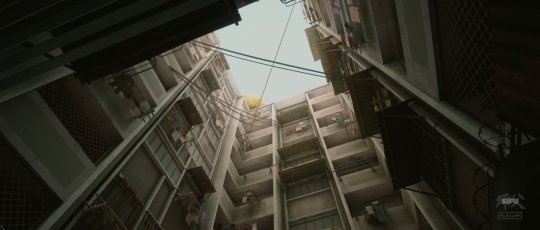
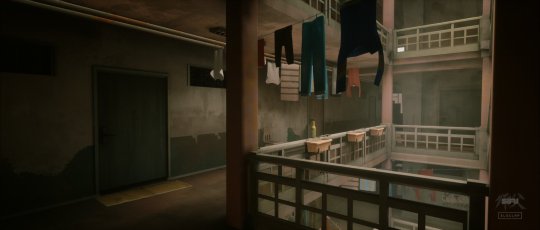

Notwithstanding of its renaissance during the 128-Bit era, the beat 'em up genre is commonly associated with the arcade games of the late 80s and 90s, the period of time when it flourished and, arguably, reached its zenith. The simplicity of controls and ease of access sufficed to attract players to the arcade cabinet, while the frequently extreme levels of difficulty of advanced levels ensured a steady flow of cash for arcade room owners and game development companies alike. Nevertheless, the genre has but perished and, in many aspects, recent years have indeed elevated it to unforeseeable degrees of complexity. Sifu, by Sloclap, synthesizes the elation of digital hand to hand combat simulation with the real-life complexity of mastering a martial art.
As is the case of previous entries in this list, Sifu makes no admitted reference to Kowloon or Hong Kong. However, the designers left little to the imagination in what pertains to their inspirations when taking on the task of constructing the game's environments. Another notable coincidence stems from the fact that this production was made possibly with the support from a celebrated independent game funding group going by the name Kowloon Nights.
Stray - BlueTwelve Studio - 2022


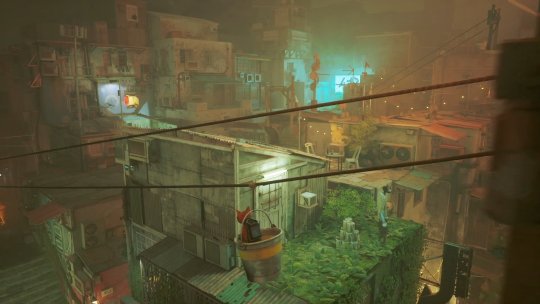
Stray is one of the most revered independent video games in recent memory, and justifiably so. The long development process yielded many benefits, judging from the consistency and attention to detail that engrossed many an avid player. That the main character is singularly charming feline may have played an equally crucial role.
The creators have made no effort to conceal the fact that the notorious Hong Kong district was a pivotal influence to the design of its nameless city. The first indication can be spotted in the game's earliest footage, in which a black cat traverses a street where a particularly conspicuous sign boasted the initials HK. Stray is less concerned with presenting a precise replica of Kowloon than it is about summoning the very essence of its atmosphere. Moreover, in an exquisitely poignant way, its ending lends an entirely new meaning to the term walled city. In the future, robots may well take the place of humans. Invariably, the Walled City is no more.
Slitterhead - Bokeh Game Studio - Work in Progress


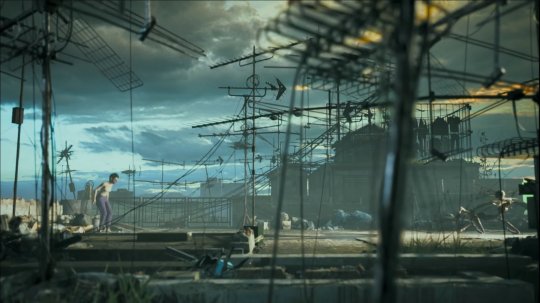
An sequence of unconscionable mistakes from the part of Sony Computer Entertainment's management galvanized Keiichiro Toyama to part ways with Japan Studio, as it once was, and establish his own game production label. Their debut title, Slitterhead, is described as a grotesque survival horror experience, a genre within which the author moves with matchless ease.
Among the few certainties regarding this project is the fact that it will take place prominently - if not exclusively - within the Kowloon City province. A wide variety of aspects included in the preview footage leave the viewer optimistic as to this being one of the most accomplished portrayals of the district ever seen in a video game. Subtle yet telling signs already demonstrate the creator's in-depth knowledge of the quarter's architecture and history.
Take, for instance, the suggestive image of the airplane flying mere meters above the top of the buildings. Although the growth of Kowloon was for the most part ungoverned, buildings did not rise above a certain height, even as inhabitants claimed for increased availability of space. This is due to the fact that airplanes landing at the nearby airport would be required to make their descent at relatively low altitude, performing a tight curve as they soared just above the enclave, thus preventing construction from expanding upwards. Another scene shows a child playing on the rooftops of the buildings, which once again is consistent with the documented habits of residents who, starved for sunlight and open space elsewhere within the city limits, had little alternative than to take the stairs all the way to the top.
Warehouse Kawasaki Arcade

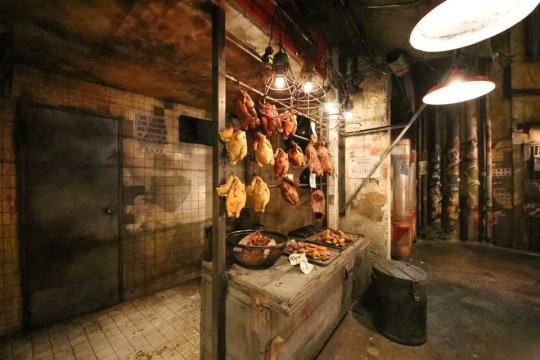

I would be remiss not to make some form of allusion to Warehouse Kawasaki, an arcade built to replicate the Walled City with unthinkable detail. Though its ultimate purpose was for visitors to engage in digital entertainment, the venue was scrupulously put together. Point in fact, many of the objects used in the construction of the five floor amusement centre were imported directly from Hong Kong. Like so many other Japanese arcades, it closed its doors in 2019.

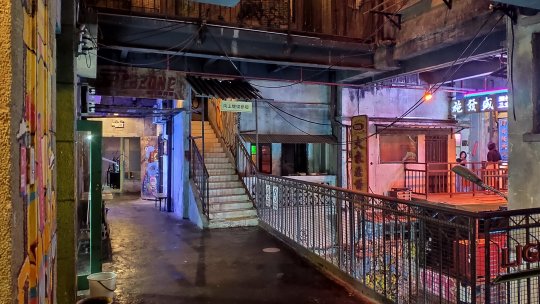
In recent years, a rather similar initiative was taken by the Chinese in their attempts to build unique mall spaces. The 文和友 malls in mainland China, found in Changsha, Guangzhou and Shenzhen, attempt to reproduce the walled city aesthetic. Local residents inform me that these are increasingly lacking in foot traffic, for which reason the majority of their stores are closed.
Other digital replicas of Kowloon

A number of other videogames set in or deriving inspiration from Kowloon could not be featured in this article.
A frequently cited reference in this context is the action/adventure game Fear Effect, one which I emphatically dispute. No doubt remains as to it being located in a futuristic version of Hong Kong, yet I could discern no parallels with the walled city, save for those scattered second-hand visual motifs that were no doubt imported from sci-fi classics such as Blade Runner or Ghost in the Shell.
The Utelek Complex stage of Deus Ex: Makind Divided presents a similar situation, where the overall atmosphere of the futuristic favela bears some resemblance to Kowloon, without meeting the specificity quota that would warrant a more comprehensive exploration.
The 2004 Shout! original Kowloon High-School Chronicle for the PS2 is a unique case, in that it borrows the city's name despite taking place in a massive, Tokyo underground dungeon that is later revealed to be a maze-like Egyptian pyramid. The odd choice of title remains unclear.
Shadowrun: Hong Kong game (screenshot above) contains a very direct mention of Kowloon as the place in which an entire episode comes to pass. Another project still in development, Kowloon's Curse (screenshot below), is following the lead of many popular independent horror games in recent memory by using a visual design and structure that elicits memories of the late Playstation/early Dreamcast era. A short prequel episode was made available earlier this year, for free.
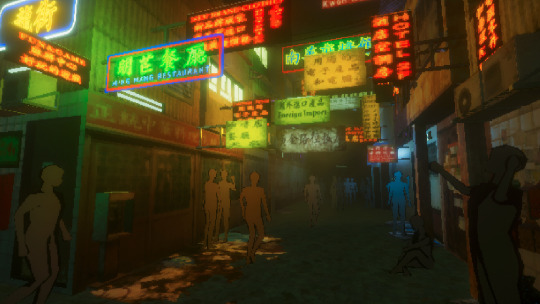
Additionally, I refrained from mentioning the Kowloon maps in Call of Duty: Black Ops or Counter-Strike: Global Offensive, as I perceive both games to be insufficiently relevant to merit study or contemplation.
A space that refuses to be forgotten
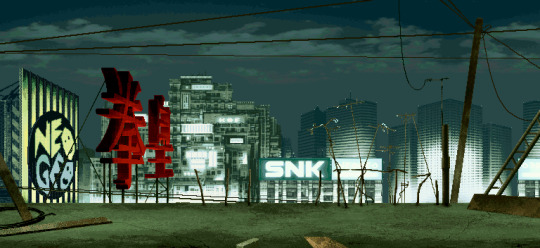
(China rooftop stage from The King of Fighters 2003)
It would be a gross overstatement to claim that Kowloon is a recurring location or level design motif in videogames. The relationship between digital games and the real life ghetto has been one of sporadic references. What makes the subject so engrossing pertains to the quality of the relationship, particularly that of a small cadre from among the titles featured in this article. Kowloon's Gate was one of the most relevant game creations of the 32-Bit era, a game deserving of reverence and cult following inside and outside Japan. Likewise, Shenmue II is the second instalment of a truly ground-breaking and highly advertised series whose production costs alone were unmatched until quite recently.
Moreover, this is an affair that is far from concluded. The unexpectedly high number of allusions to Kowloon in videogames released or revealed just last yet demonstrates that its aesthetic is still very much present in the minds and hearts of artists and designers working in the field. The walled city lives on as a digital demarcation that is certain to resurface time and again in years to come.
#kowloon's gate#kowloon's gate VR suzaku#jetman#stranglehold#john woo#kowloon walled city#hong kong#resident evil 6#poisawan#paranormal hk#ghostpie studio#sifu#kowloon nights#stray#slitterhead#bokeh game studio#keiichiro toyama#Warehouse Kawasaki#arcade#文和友
153 notes
·
View notes